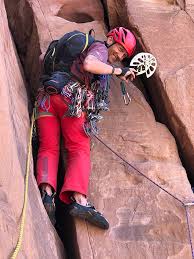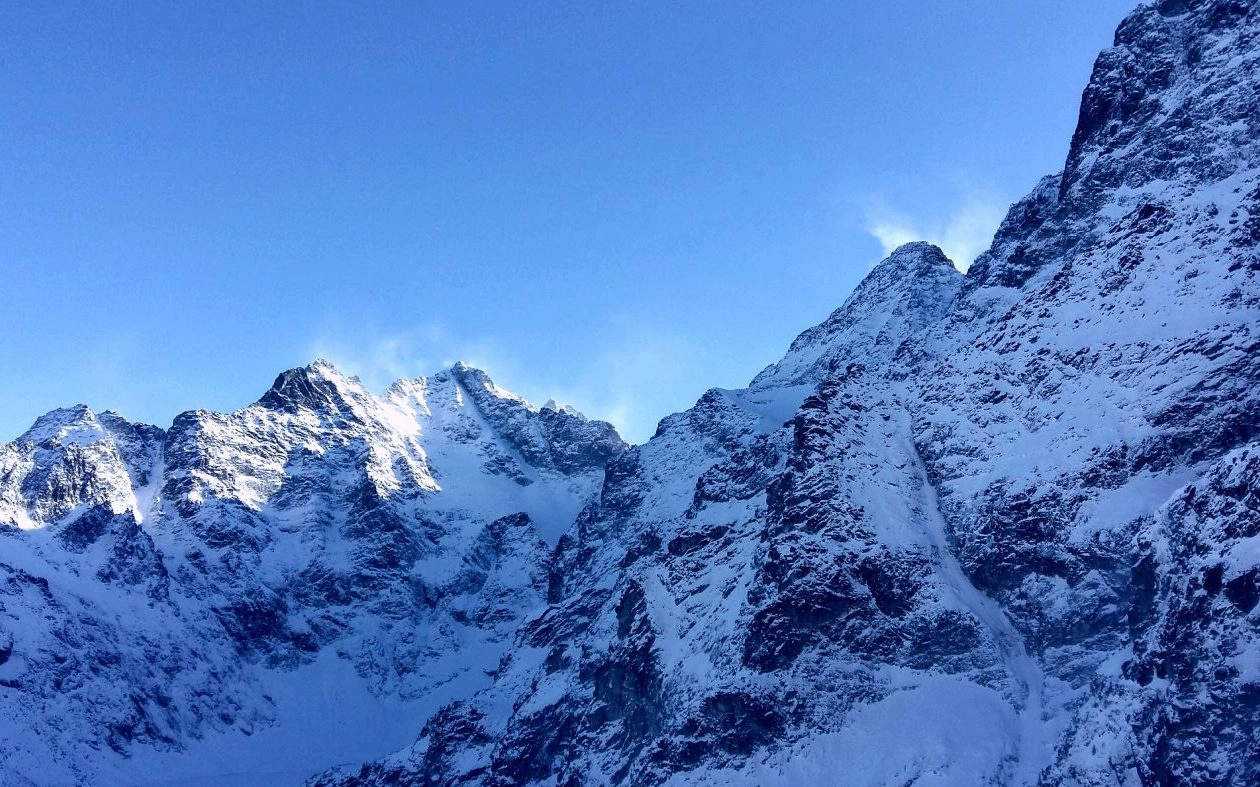Relatively often, too often, we hear sad information about accidents in the mountains. More and more people are starting their adventure in this beautiful, but also demanding environment. Many of them take shortcuts, being unaware of the risks, but also not realizing that mountain experience is gained over the years – through courses, tours, climbing with experienced partners.
I had the pleasure to take a part in a lecture done by an experienced Polish Tatra Mountain Instructor, Piotr Sztaba, from one of the best climbing schools in Poland, about what a model path of development and gaining mountain experience can look like, and about the dangers that everyone faces when deciding to go on to the mountains, especially in wintertime.
Below are some of the best Q&A from the interview made by Piotr Turkot from Outdoor Magazine with Piotr after the lecture.
Piotr Turkot: Winter mountaineering and winter climbing are associated with objective dangers that can lead to tragic accidents. Can you then say that the mountains in winter are not for everyone?
Piotr Sztaba: The mountains are for everyone, even if there is a risk involved in exploring them. I think you just wanted to ask if people can be prevented from going to the mountains in the wintertime. The foundation of the mountains is freedom. This freedom is based on the fact that we can make our own decisions and face the consequences associated with mountain activities we chose to do. Some people disagree with this and would like to see some more regulation, however, it is worth appreciating the fact that a diverse and independent society is stronger, we also need some risk-takers with different life values. The mountains should be open and accessible to everyone who is willing to accept risk. In my opinion, it should not be like a world we live in daily, a world controlled, full of restrictions, barriers, and regulations.
PT: In the public space there are many voices from mountain rescue services, guides, instructors that in order to be safe in the mountains you need at least basic competence and common sense. Unfortunately, some people do not get this message. How can we convince them that basic knowledge and responsibility are badly needed in the mountains?
PSZ: I think there are several overlapping factors here. You need to be aware that while the mountains forgive many mistakes in summer, they become much more dangerous in winter. Snow and ice mean that we are not really dealing with tourism anymore. Classic mountaineering begins here. Remember that in winter in the mountains, during several hours of climbing or mountaineering to higher parts, we could make 25,000 steps or more and each of these 25,000 steps may turn out to be a fatal one. Mountains in winter are simply many, many times more dangerous and require a certain set of skills and competency. That set of skills and competencies needs to be gained over many years with a professional and organised approach. If we would learn to ride a bike without an instructor – then, of course, we are at risk of scratches and bruises. But when we would try to learn to drive a car without an instructor, the consequences of mistakes are so much bigger not only for us. The complexity of the problems and skills to learn is many times greater because the risks are many times greater in winter conditions.
PT: Of course, it would be better if such logic existed in our society. On the other hand, there are people who go to the mountains without even thinking that they may need such knowledge.
PSZ: The reasons why we go to the mountains are quite simple. The beauty of nature, adrenaline, self-discovery, friendships, challenges or even temptation and applause. There are many things in the mountains that attract us. Of course, all these reasons are good, maybe apart from the applause. At the same time, however, it must be remembered that there are slightly different rules and skills than the ones at sea level. That there is much less room for improvisation, easygoing attitude and stupid mistakes. I observe in many mountain lovers, what I experienced myself years ago – a kind of infatuation. And paradoxically, it is extremely dangerous because it causes a sort of blindness. We do not see things that can be deadly.
PT: It happens that today this infatuation is built in a slightly artificial way – every now and then on social media we see beautiful pictures of people in the mountains doing various extreme feats. Some portals, social groups have hundreds of thousands of followers who instantly like and applaud those “heroes”. How professionals instructors, and guides – can join discussions, share their observations, and basic advice, and make people aware of the risk?
PSZ: When I see someone in the mountains, in difficult and risky terrain, as an experienced instructor I can quickly recognize how his/her sense of balance works, what his/her habits are or is he/she in control of the situation, does he/she pose a threat to himself/herself and others? An experienced climber, instructor or guide moving un-roped in the exposed terrain does not raise my concern. On the other hand, ill-skilled tourists, crawling with a rope on a 35-degree angle slope, using only the front teeth of crampons and two technical ice axes with a rope tangled between the legs are really frightening me. You can see immediately that they have no control over anything and therefore are also dangerous to others. Unfortunately, in such situations, it is often difficult to react and give advice. After all, this can be perceived as a personal attack and lead to an unpleasant exchange of words. And yet we want to have a good time in the mountains. However, I am trying to react with a subtle and understanding approach, because I think that one of our roles – the mountain professionals’ role – is to advise and warn.
Coming back to the problem of social media. I would warn Facebook, Instagram etc. followers that thoughtless admiration for unprofessional and often dangerous feats can wind up those “heroes” and lead to an accident during subsequent attempts to do something even more spectacular. Please think twice when commenting that this is very inspiring and amazing, that their live threatening climbs deserve congratulations and applause. A huge responsibility rests on the shoulders of the administrators of popular mountain social media. They should not allow the posting of such materials that are clearly unprofessional, and we can see that people who are doing them are in danger. This is a self-winding spiral of increased risk for all users of the mountains.
PT: Do you have access to certain statistics related to fatal accidents in the mountains? What conclusions you can draw from them?
PSZ: Yes I have. Thanks to this data, we can identify the causes of accidents in the mountain. In the first place are the falls and trips from heights, which happened on easy terrain, the terrain which is attractive for “winter tourism” or classic mountaineering. An example is when climbers move together, still, rope up but they do not place protection. The terrain is easy for them and at the same time, it is slippery, icy, wet or a slope is an avalanche-prone slope. Is worth noting that coming down is also most of the time harder than climbing up. We have to stay focused and be competent at all times. If we are focused, we automatically minimize the risk. On the other hand, if we lose focus, then a relaxed attitude creeps in, fatigue and haste are catching on us and the false feeling that the worst is behind us could lead to an accident!
Another major cause of death is avalanches, which have always taken a heavy toll. This is slowly changing due to more courses and training people getting, awareness and less snow… There used to be a lot more snow and the winters lasted longer.
For several years now it has been seen that most accidents happen during the icing period. This icing used to occur several decades ago only in autumn and spring, now with global warming, we have this time almost at any given time in winter. The temperature rises and melts the snow then, the frost catch at night and ice and snow hardens. I think that the lack of basic skills, such as the correct use of crampons and an ice axe, is a decisive factor in the accident toll, precisely because of the increasing number of periods when there is hard ice and less snow.
PT: Do these statistics show to whom these types of accidents happen most often?
PSZ: Most often they happen to people in their first 3 years of mountaineering and climbing. This is the most dangerous period. Is trivial but people with less experience have more accidents. Here I would go back to learning through experience. You can learn mountaineering skills on your own. It will take a long time and you will expose yourself to great risk, and at the same time, you must remember that you do not discover new things. All have been done before so is better to get these skills from a more experienced mountaineering club mate or on the climbing/mountaineering course from the instructor or guide.
PT: So in your opinion, a professional course or guiding service should be considered by every mountain apprentice?
PSZ: We have three acceptable solutions here: learning from our mistakes, peer training and training with a specialist. I have already mentioned the first option. As for peer training, hardly anyone today has time to give up their own climbing and go with a beginner to the mountains to train him. But the “peer-to-peer” version may be a good solution and definitely better than the first option.
The course or guide service is not necessary to operate in the mountains, is also not needed to be successful in the mountains. However learning from professionals, is necessary when you want to learn to consciously minimize the risk, quickly see threats, draw conclusions, base your activities on the safest and often unintuitive techniques etc. Taking a course does not guarantee that you will be 100 per cent safe. Although there will be fewer errors after the course and you will be well prepared there are lots of complex factors deciding about safety. Is worth remembering that mountains are a space with extremely high objective risk, and it is also worth having a bit of luck not to end up in the wrong place at the wrong time.
I always say is much better and easier to start with the course. However, the key to development is skillfully combining knowledge from the courses with independent practice. Going from course to the course does not do much if we talk of being independent. I also suggest that beginners spend most of their free time learning the basics like navigating, crampons technique, knots and ropework etc., it will stay forever.
The future ambitious climber must decide for himself what is best for him.
PT: You have to be prepared for the risk in the mountains. You have to be able to analyse them. For this, you need experience and skills to gain appropriate competencies. Is there an ideal development path?
PSZ: First you need to know what are the reasons that mountains are appealing to you. You have to feel it. The motivation here is key. The common reason has always been a need for contact with beautiful nature, curiosity, and a need for adventure. It also often happens that we are drawn to the mountains for personal reasons like the desire to fight our weaknesses.
Basic physical fitness is necessary. To be able to trek the mountain trails in the summer at times shorter than those described in the guidebooks is a good start. With this in mind, you have to answer the question of what you want to do in these mountains. If it is winter ascending the easiest way to the top of the peaks as I said classic mountaineering style, then you should complete at least the basic winter mountaineering course. If you want to hike in alpine terrain, it is best if you complete an alpine course.
If you want mountain climbing, this is a long way. The best is to start with a rock climbing course. After that, it will be necessary to climb independently on climbing walls and on rocks for a few months regularly. Then you will be ready for the second stage, i.e. the mountain climbing course. After the course, it’s time to gain independence again in this area. You should spend additional 5-6 days a year climbing in the mountains apart from regular training and climbing on rocks.
After about three years of climbing and training, everything becomes less risky – you will have basic climbing skills that allow us to consciously manage risk while operating in the mountains.
PT: What about winter climbing?
PSZ: This is the next step. Again, you should start with the winter climbing course, then climb on your own and go to the Alps in summer, to learn to manage glaciers risk. And finally, after two such seasons, go to the Alps in winter.
This is from my experience the best way. Do this for 7-10 years with moderate intensity and slowly increase the difficulty, explore new mountains, meet people and develop in every area related to climbing. It’s worth climbing on rocks sport and trad style, training on a wall with a structured plan, trekking, skiing, climbing in summer and winter in the mountains. You should spend as much time and money as possible to be out there. This diversity builds experience and toughens the body and mind. At the same time do not fall into the trap of buying lots of fashionable clothes and gear. If you spend a lot of money on this stuff then you need to work more than you can’t be that often in the mountain to get experience. Remember even the best equipment without the skills is worth nothing.
Source Piotr Turkot & Piotr Sztaba

Piotr Sztaba has been climbing for 30 years. For the last 10 years, he has been an active Tatra Mountain Instructor of PZA (Polish Alpine Association). His mountain climbing was influenced by the extraordinary characters of people gathered around the KS Korona club in the early 1990s and Mountain Club in Kraków. Climbing and mountains are present in his life all the time. During his years of climbing, he says he has not missed any season! Climbing on the rocks and in the mountains of Scotland, Rocky Mountains, Atlas, Dolomites, Alps, Pamirs, Axu, Karakoram and of course the Tatra Mountains.



